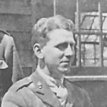Edward Victor Appleton
| Sir Edward Appleton | |
 Edward Victor Appleton in army uniform, taken in World War I.
|
|
| Born | September 6, 1892 Bradford, West Yorkshire, England |
|---|---|
| Died | April 21, 1965 (aged 72) Edinburgh, Scotland |
| Nationality | English |
| Fields | Physics |
| Institutions | Cambridge University King's College London Edinburgh University |
| Alma mater | Cambridge University |
| Doctoral advisor | J. J. Thomson Ernest Rutherford |
| Notable students | J. A. Ratcliffe |
| Known for | Ionospheric Physics Appleton layer |
| Notable awards | Nobel Prize in Physics 1947 |
Sir Edward Victor Appleton, GBE (September 6, 1892 – April 21, 1965) was an English physicist.
Contents |
Biography
Appleton was born in Bradford, West Yorkshire and educated at Hanson Grammar School. At the age of 18 he won a scholarship to St John's College, Cambridge. He graduated with a first class degree in Natural Sciences.
During the First World War he joined the West Riding Regiment, and later transferred to the Royal Engineers.
After returning from active service in World War I, Appleton became assistant demonstrator in experimental physics at the Cavendish Laboratory in 1920. He was professor of physics at King's College London (1924–36) and professor of natural philosophy at Cambridge University (1936–39). From 1939 to 1949 he was secretary of the Department of Scientific and Industrial Research. Knighted in 1941, he received the 1947 Nobel Prize in Physics for his contributions to the knowledge of the ionosphere, which led to the development of radar.
In 1902 Oliver Heaviside and Arthur Edwin Kennelly independently proposed the idea of there being a conducting layer that reflected radio signals. Guglielmo Marconi had been able to make his historic transatlantic transmissions; to achieve this, refraction of the signals was necessary to reach its destination.
In his work, Appleton had observed that the strength of the radio signal from a transmitter on a frequency such as the medium wave band and over a path of a hundred miles or so was constant during the day but that it varied during the night. This led to him to believe that it was possible that two radio signals were being received. One was traveling along the ground, and another was reflected by a layer in the upper atmosphere. The fading or variation in strength of the overall radio signal received resulted from the interference pattern of the two signals.
To prove his theory, in 1924 Appleton used the British Broadcasting Corporation (BBC) radio broadcast transmitter at Bournemouth, England. This transmitted a signal towards the upper reaches of the atmosphere. He received the radio signals near Cambridge, proving they were being reflected. By making a periodic change to the frequency of the broadcast radio signal he was able to measure the time taken for the signals to travel to the layers in the upper atmosphere and back. In this way he was able to calculate that the height of the reflecting layer was 60 miles above the ground.
From 1949 until his death in 1965, he was Principal and Vice-Chancellor of the University of Edinburgh.[1]
In 1974 the Radio and Space Research Station was renamed the Appleton Laboratory in honour of the man who had done so much to establish the UK as a leading force in ionospheric research, and had been involved with the station first as a researcher and then as secretary of its parent body, the Department of Scientific and Industrial Research.
Legacy
- the Rutherford Appleton Laboratory
- the Appleton Tower at the University of Edinburgh
- the Appleton Science Building at Bradford College
- The Appleton crater on the Moon was named in his honour.
- The Appleton Layer, which is the higher atmospheric ionized layer above the E-layer
- The annual Appleton Lecture at the Institute of Engineering Technology, IET.
See also
- Kennelly-Heaviside layer
Notes
- ↑ Lister, Derek A J (2004). Bradford's Own. Sutton. ISBN 0-7509-3826-9.
References
- Süsskind, Charles (1970). "Appleton, Edward Victor". Dictionary of Scientific Biography 1. New York: Charles Scribner's Sons. 195-196. ISBN 0684101149.
External links
- "Sir Edward Victor Appleton". nobelprize.org. Accessed October 21, 2007. (Citation: Nobel Prize in Physics: 1947, "for his investigations of the physics of the upper atmosphere especially for the discovery of the so-called Appleton layer." [Hyperlinked account. Provides link to BBC Historic Figures biography.]
- "Sir Edward Victor Appleton: Nobel Prize in Physics 1947" – Biography from Nobel Lectures, Physics 1942-1962 (Amsterdam: Elsevier Publishing Company, 1964). [Hyperlinked in previous entry.]
- "Sir Edward Victor Appleton (1892 - 1965): Appleton was an English physicist and Nobel prize winner who discovered the ionosphere." Historic Figures, bbc.co.uk. Accessed October 21, 2007. (Photograph of Appleton c. 1935 ©). [Provides link to Nobel Foundation account, listed above.]
| Academic offices | ||
|---|---|---|
| Preceded by Sir John Fraser |
Principals of Edinburgh University 1948–1965 |
Succeeded by Michael Swann |
|
||||||||
|
||||||||